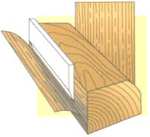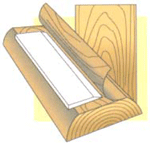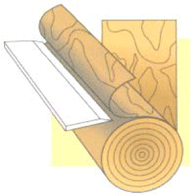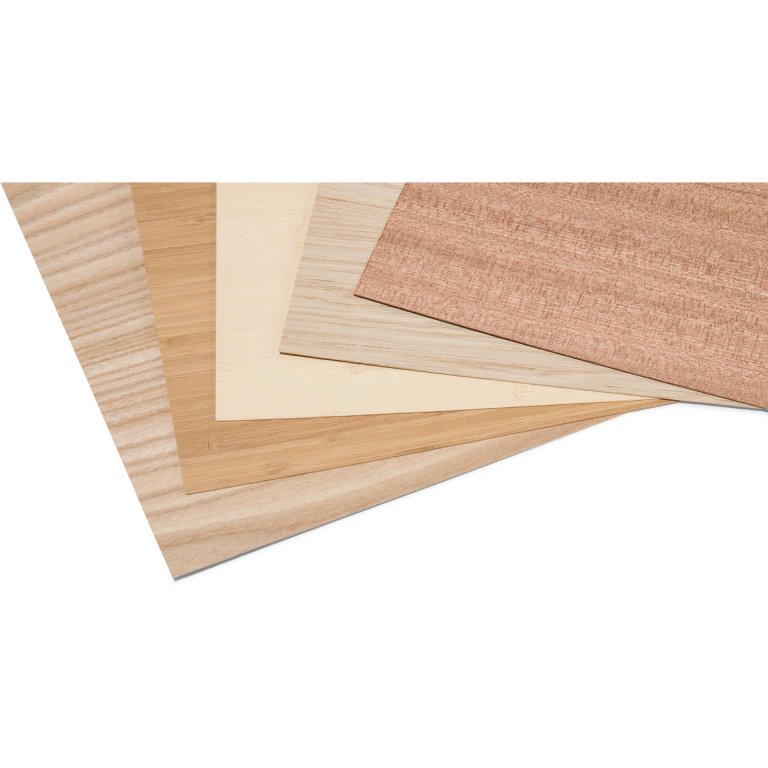| Article No. | |
|---|---|
| Material | Real wood veneer on special paper backing |
| Classic quality | Canadian maple (flower), natural / steamed bamboo (stripe), Finnish birch (rotary cut veneer), European oak (flower), American cherry (flower), American walnut (stripe). (flower), Walnut americ. (flower) |
| Architectual quality | European Beech (flower), Ash (stripe), Carolina Pine (stripe), Radita Pine (flower), Oregon Pine (stripe), Red Brush (flower), Mahogany afric. (stripe), Paduk (stripe), Teak (flower), Wenge (stripe), Zebrano (stripe), Bubinga (stripe) |
| Veneer thickness | approx. 0.6 mm |
| Further properties | neutral glued (E1), 2 x sanded ex works (grain 120 and 150), longitudinal grain pattern |
Larger formats up to 2500 x 1240 mm on request from our team for professionals.
Properties and application: Decoflex is a real wood veneer that is neutrally glued to a special paper backing and then "broken" parallel to the grain without the breaks in the veneer surface being visible. This gives the material an extremely high degree of flexibility parallel to the grain and is also suitable for processing round shapes that could not previously be veneered (min. radius approx. 5 mm). At right angles to the grain, the stiffness of the original veneer is retained with a lower tendency to splinter.
Apart from use on curved surfaces made of various materials (see processing), Decoflex can also be used on flat surfaces. The time and cost savings are the most important argument for using Decoflex veneers, as they can be processed more efficiently and quickly than classic veneers. In addition to being used as a veneer, Decoflex can of course also be used as a "pure" material. For example, it can be used as a book cover, for model making, for the production of jewelry and accessories (e.g. placemats) and much more.
The reverse side of Decoflex consists of special brown paper, which is selected by the manufacturer in the approximate color of the veneer (e.g. chamois for maple, dark brown for walnut). The gluing between the veneer and paper complies with the E1 standard and is water-resistant. However, Decoflex is not suitable for outdoor use.
Slicing techniques: All veneers are cut from the log with a knife. The knife, or rather the process, can be simplified as if you were working with a very wide chisel. The pattern of the wood is primarily determined by the cutting technique. The veneer papers in our range have been cut in the following ways:
Stripe: The log is cut in such a way that the finished veneer has a pattern of almost parallel lines. This relative regularity is achieved by cutting the annual rings at right angles.
 |
Flower: The image of the veneer is more irregular than with strip cuts. Imagine a log divided lengthwise - the veneer slices are then made parallel to the dividing cut, i.e. at a cutting angle rotated by 90° compared to the strip cut.
 |
Rotary cut veneer: This term is almost self-explanatory: The knife peels off a thin layer on the outside of the log, which theoretically makes the largest sections possible in one piece, as a section is no longer limited by the diameter of the tree. This results in irregular, moving drawings.
 |
Processing: Decoflex can be glued to a wide variety of surfaces. The choice of glue depends primarily on the substrate material selected. If you are working without a veneer press, the manufacturer recommends using a high-quality contact adhesive (e.g. Pattex Compact Gel). If Decoflex is applied with a press, normal PVA glue (e.g. Ponal Express) or formaldehyde glue can be used. In both cases, the manufacturer recommends not to save on glue.
If the glue is not applied with a spray gun but with an adhesive spatula, care must be taken to ensure that the surfaces to be glued are spread at an angle of 90° to each other. Before the veneer is applied to the substrate, the outer areas are temporarily covered with paper or cardboard so that Decoflex can then be pressed down firmly, smoothed from the center to the sides and the paper gradually removed.
Always follow the instructions of the glue and varnish manufacturer during application. Glues and varnishes must never contain substances that interact with each other. The manufacturer recommends storing Decoflex veneer, glue, backing material and processing products in the same room before gluing to prevent blistering or veneer cracking. After gluing, wait 4 - 5 days before varnishing so that the glue can dry out properly.
For a smooth and perfect-looking surface, Decoflex veneers must be finely sanded again (e.g. 240 and 320 grit) before varnishing, despite the factory sanding (120 and 150 grit). Do not use water-soluble varnish for varnishing, but solvent-based varnish (e.g. Clou Holzlack L1). Biofarben hard oil, for example, is suitable for oiling
Free standard delivery within Germany and free collection from Modulor in Berlin for orders over 89 €.
5,95 € shipping costs, if order value is less than 89 € (DE)
2,95 € for pick-up at the store in Berlin, if order value is less than 89 €
Express and forwarding shipping
From 19 € express surcharge you will receive your order particularly quickly with standard shipping within Germany.
From 69€ is the cost of shipping within Germany. You can recognize articles with forwarding shipping in the store by the truck symbol .
Especially for Berlin
From 34.90 € courier shipping for standard and forwarding goods.
- Free returns for standard shipping within Germany
- Extended, voluntary return policy of 30 days for complete, undamaged goods in their original packaging
- You are responsible for the cost of returns for forwarding goods and returns from a country outside Germany
Excluded from returns
Excluded from returns are sections of rolled goods, cut-to-size pieces and other goods made especially for you, as well as used goods, newspapers, magazines and periodicals, Modulor vouchers and items that we do not carry in our range but have ordered at your request.
Good to know: The furniture variants in our configurators that can be delivered quickly are not cut to size, but standard formats that can be returned.
| Article No. | |
|---|---|
| Material | Real wood veneer on special paper backing |
| Classic quality | Canadian maple (flower), natural / steamed bamboo (stripe), Finnish birch (rotary cut veneer), European oak (flower), American cherry (flower), American walnut (stripe). (flower), Walnut americ. (flower) |
| Architectual quality | European Beech (flower), Ash (stripe), Carolina Pine (stripe), Radita Pine (flower), Oregon Pine (stripe), Red Brush (flower), Mahogany afric. (stripe), Paduk (stripe), Teak (flower), Wenge (stripe), Zebrano (stripe), Bubinga (stripe) |
| Veneer thickness | approx. 0.6 mm |
| Further properties | neutral glued (E1), 2 x sanded ex works (grain 120 and 150), longitudinal grain pattern |
Larger formats up to 2500 x 1240 mm on request from our team for professionals.
Properties and application: Decoflex is a real wood veneer that is neutrally glued to a special paper backing and then "broken" parallel to the grain without the breaks in the veneer surface being visible. This gives the material an extremely high degree of flexibility parallel to the grain and is also suitable for processing round shapes that could not previously be veneered (min. radius approx. 5 mm). At right angles to the grain, the stiffness of the original veneer is retained with a lower tendency to splinter.
Apart from use on curved surfaces made of various materials (see processing), Decoflex can also be used on flat surfaces. The time and cost savings are the most important argument for using Decoflex veneers, as they can be processed more efficiently and quickly than classic veneers. In addition to being used as a veneer, Decoflex can of course also be used as a "pure" material. For example, it can be used as a book cover, for model making, for the production of jewelry and accessories (e.g. placemats) and much more.
The reverse side of Decoflex consists of special brown paper, which is selected by the manufacturer in the approximate color of the veneer (e.g. chamois for maple, dark brown for walnut). The gluing between the veneer and paper complies with the E1 standard and is water-resistant. However, Decoflex is not suitable for outdoor use.
Slicing techniques: All veneers are cut from the log with a knife. The knife, or rather the process, can be simplified as if you were working with a very wide chisel. The pattern of the wood is primarily determined by the cutting technique. The veneer papers in our range have been cut in the following ways:
Stripe: The log is cut in such a way that the finished veneer has a pattern of almost parallel lines. This relative regularity is achieved by cutting the annual rings at right angles.
 |
Flower: The image of the veneer is more irregular than with strip cuts. Imagine a log divided lengthwise - the veneer slices are then made parallel to the dividing cut, i.e. at a cutting angle rotated by 90° compared to the strip cut.
 |
Rotary cut veneer: This term is almost self-explanatory: The knife peels off a thin layer on the outside of the log, which theoretically makes the largest sections possible in one piece, as a section is no longer limited by the diameter of the tree. This results in irregular, moving drawings.
 |
Processing: Decoflex can be glued to a wide variety of surfaces. The choice of glue depends primarily on the substrate material selected. If you are working without a veneer press, the manufacturer recommends using a high-quality contact adhesive (e.g. Pattex Compact Gel). If Decoflex is applied with a press, normal PVA glue (e.g. Ponal Express) or formaldehyde glue can be used. In both cases, the manufacturer recommends not to save on glue.
If the glue is not applied with a spray gun but with an adhesive spatula, care must be taken to ensure that the surfaces to be glued are spread at an angle of 90° to each other. Before the veneer is applied to the substrate, the outer areas are temporarily covered with paper or cardboard so that Decoflex can then be pressed down firmly, smoothed from the center to the sides and the paper gradually removed.
Always follow the instructions of the glue and varnish manufacturer during application. Glues and varnishes must never contain substances that interact with each other. The manufacturer recommends storing Decoflex veneer, glue, backing material and processing products in the same room before gluing to prevent blistering or veneer cracking. After gluing, wait 4 - 5 days before varnishing so that the glue can dry out properly.
For a smooth and perfect-looking surface, Decoflex veneers must be finely sanded again (e.g. 240 and 320 grit) before varnishing, despite the factory sanding (120 and 150 grit). Do not use water-soluble varnish for varnishing, but solvent-based varnish (e.g. Clou Holzlack L1). Biofarben hard oil, for example, is suitable for oiling
Free standard delivery within Germany and free collection from Modulor in Berlin for orders over 89 €.
5,95 € shipping costs, if order value is less than 89 € (DE)
2,95 € for pick-up at the store in Berlin, if order value is less than 89 €
Express and forwarding shipping
From 19 € express surcharge you will receive your order particularly quickly with standard shipping within Germany.
From 69€ is the cost of shipping within Germany. You can recognize articles with forwarding shipping in the store by the truck symbol .
Especially for Berlin
From 34.90 € courier shipping for standard and forwarding goods.
- Free returns for standard shipping within Germany
- Extended, voluntary return policy of 30 days for complete, undamaged goods in their original packaging
- You are responsible for the cost of returns for forwarding goods and returns from a country outside Germany
Excluded from returns
Excluded from returns are sections of rolled goods, cut-to-size pieces and other goods made especially for you, as well as used goods, newspapers, magazines and periodicals, Modulor vouchers and items that we do not carry in our range but have ordered at your request.
Good to know: The furniture variants in our configurators that can be delivered quickly are not cut to size, but standard formats that can be returned.
